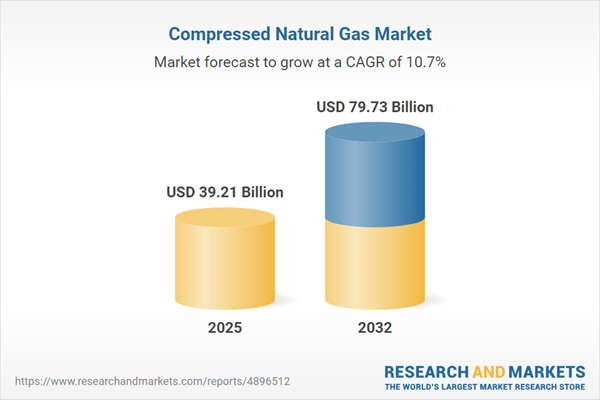Speak directly to the analyst to clarify any post sales queries you may have.
Senior decision-makers in the compressed natural gas market face growing pressures to accelerate infrastructure development, enhance operational resilience, and align with regulatory requirements. As organizations pursue sustainability and risk mitigation, targeted market intelligence is essential for evaluating investment opportunities and shaping future-ready strategies in this dynamic sector.
Market Snapshot: Compressed Natural Gas Market Outlook
The global compressed natural gas market is experiencing strong forward momentum, supported by increased adoption across diverse industries and geographies. Valued at USD 35.42 billion in 2024, the market is projected to reach USD 39.21 billion by 2025, reflecting a compound annual growth rate (CAGR) of 10.67%. Investors display significant confidence, driven by substantial infrastructure investments and continual technological improvements. Intensifying interest in clean fuel alternatives is spurring innovation, improving supply chain reliability, and encouraging the development of adaptive business models. These trends help companies increase efficiency, sharpen sustainability efforts, and respond to evolving regulatory expectations.
Scope & Segmentation: Drivers and Dynamics in Compressed Natural Gas Market
- End Use: Automotive fleets, public transit, and logistics companies turn to compressed natural gas to optimize fuel efficiency and curb emissions. Industrial users—including chemicals, power generation, extraction industries, food processing, metals, and utilities—leverage it for stable operations and compliance. Consistent supply plays a key role in maintaining customer trust and operational continuity.
- Source: Supply stems from associated gas collected during oil production and non-associated gas sourced independently. Balanced sourcing helps ensure continuous access and minimizes supply-related disruptions, supporting energy requirements across sectors.
- Distribution Method: Delivery options encompass centralized depots, pipelines, mother-daughter stations, and virtual pipeline networks. These methods improve responsiveness to market needs—serving urban centers and remote locations—while optimizing logistics and aligning delivery solutions with specific industry requirements.
- Geographical Coverage: Sector drivers vary globally. In North America, network infrastructure expansion is a priority. Latin America and Europe focus efforts on adapting to regulatory and compliance-driven changes. Asia-Pacific pursues modular and flexible logistics, addressing unique distribution demands. The Middle East and Africa emphasize flexible deployment strategies for diverse operational environments. Regional dynamics often determine growth trajectories and entry strategies.
- Leading Companies: Organizations such as Atlas Copco AB, Ingersoll Rand Inc., Siemens Energy AG, Baker Hughes Company, Schlumberger Limited, Gardner Denver Holdings Inc., Kaeser Kompressoren SE, BOGE Kompressoren GmbH, Hitachi Ltd., and Ariel Corporation set industry benchmarks, drive innovation, and advance operational best practices across the compressed natural gas value chain.
Key Takeaways for Senior Decision-Makers
- Operational digitalization and automation enable better oversight, fuel usage monitoring, and efficient logistics across multiple facilities.
- Partnerships with technology providers and collaboration across sectors provide flexibility as market demand changes, supporting agile supply chains and adaptation to evolving requirements.
- Routine infrastructure enhancements are critical for keeping pace with regulatory adjustments and ensuring operational resilience, reducing the risk of unplanned disruptions.
- Implementing diverse distribution networks, covering both physical and virtual channels, accelerates compliance and large-scale emissions reduction, enhancing the organization’s adaptability to policy shifts.
- Strategic risk management and the effective use of policy incentives underpin business continuity and allow proactive management of environmental, operational, and market uncertainties.
Tariff Impact on the Compressed Natural Gas Market
Recent U.S. tariff adjustments have increased component costs, leading organizations to re-examine domestic supply chain strategies. To protect margins and ensure consistent operations amid changing policy environments, senior leaders should focus on adaptable procurement and proactive risk management.
Methodology & Data Sources
This analysis is informed by expert interviews and a thorough review of current technical, operational, and business literature. Combining these perspectives delivers actionable market intelligence for executive decision-making.
Why This Report Matters for Compressed Natural Gas Market Stakeholders
- Supports fact-based investment and risk decisions aligned with emerging regulatory and operational realities, enabling strategic organizational responses.
- Delivers segmented market insights and compliance guidance to help stakeholders plan for challenges and adjust priorities.
- Provides benchmarks for technologies and processes, empowering executive teams to maintain competitive relevance within the evolving market landscape.
Conclusion
With actionable insights into drivers and compliance standards, leaders are equipped to steer resilient growth and shape sustainable strategies within the compressed natural gas sector.
Additional Product Information:
- Purchase of this report includes 1 year online access with quarterly updates.
- This report can be updated on request. Please contact our Customer Experience team using the Ask a Question widget on our website.
Table of Contents
3. Executive Summary
4. Market Overview
7. Cumulative Impact of Artificial Intelligence 2025
Companies Mentioned
The companies profiled in this Compressed Natural Gas market report include:- Atlas Copco AB
- Ingersoll Rand Inc.
- Siemens Energy AG
- Baker Hughes Company
- Schlumberger Limited
- Gardner Denver Holdings Inc.
- Kaeser Kompressoren SE
- BOGE Kompressoren GmbH
- Hitachi, Ltd.
- Ariel Corporation
Table Information
| Report Attribute | Details |
|---|---|
| No. of Pages | 198 |
| Published | November 2025 |
| Forecast Period | 2025 - 2032 |
| Estimated Market Value ( USD | $ 39.21 Billion |
| Forecasted Market Value ( USD | $ 79.73 Billion |
| Compound Annual Growth Rate | 10.6% |
| Regions Covered | Global |
| No. of Companies Mentioned | 11 |









